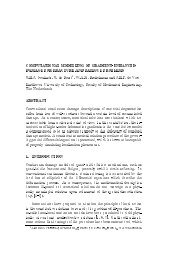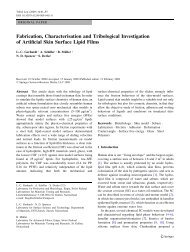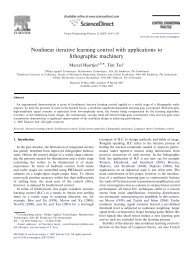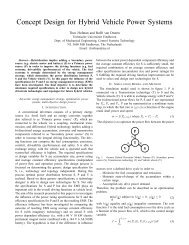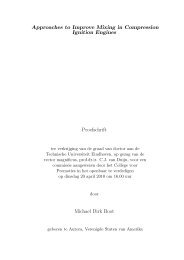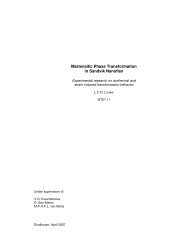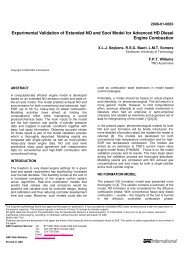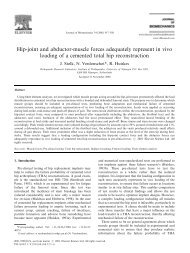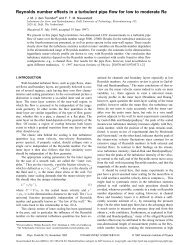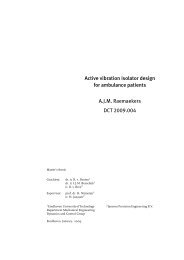Minimum gas speed in heat exchangers to avoid particulate fouling
Minimum gas speed in heat exchangers to avoid particulate fouling
Minimum gas speed in heat exchangers to avoid particulate fouling
You also want an ePaper? Increase the reach of your titles
YUMPU automatically turns print PDFs into web optimized ePapers that Google loves.
M.S. Abd-Elhady et al. / International Journal of Heat and Mass Transfer 47 (2004) 3943–3955 3949Fig. 6. A summary for the foul<strong>in</strong>g layer circumferential growth shown <strong>in</strong> Fig. 5.the middle centered tube the flow keeps attached <strong>to</strong> thetube surface and then separates at an angle of 120° fromthe stagnation po<strong>in</strong>t. From the numerical results it couldalso be concluded that there is more air circulation at thefront than <strong>in</strong> the rear end of the middle centered HEtube, Fig. 7c and d. Therefore particles that stick <strong>to</strong> therear end of the HE tube are more likely <strong>to</strong> rema<strong>in</strong> <strong>in</strong>position than particles that stick <strong>to</strong> the sides of the HEtube. A particle that sticks <strong>to</strong> the side of the HE tube rollsover the HE tube if the airflow <strong>speed</strong> is above a certa<strong>in</strong>limit, and s<strong>to</strong>ps if it is blocked by the rest<strong>in</strong>g particles atthe rear end of the <strong>heat</strong> exchanger tube. Therefore foul<strong>in</strong>gstarts at areas that are subjected <strong>to</strong> m<strong>in</strong>imum shear<strong>in</strong>gforces and then spreads due <strong>to</strong> particle transport <strong>to</strong>the already deposited particles. Fig. 6 summarizes thecircumferential growth of the foul<strong>in</strong>g layer shown <strong>in</strong> Fig.5.3.2. Limit<strong>in</strong>g foul<strong>in</strong>g <strong>speed</strong>The previous set of experiments has shown that asthe flow <strong>speed</strong> <strong>in</strong> the HE <strong>in</strong>creases, the thickness and thesurface area of the foul<strong>in</strong>g layer deposited over the HEtube are reduced. The follow<strong>in</strong>g experiments are done <strong>to</strong>determ<strong>in</strong>e the flow <strong>speed</strong> at which foul<strong>in</strong>g of the <strong>heat</strong>exchanger is prevented. The results of the experimentwill be compared <strong>to</strong> the results achieved with an analyticalmodel. The analytical model is only valid forspherical non-charged particles. The analytical model isbased on the m<strong>in</strong>imum shear velocity required <strong>to</strong> roll aparticle on a flat surface. It can be applied for a cyl<strong>in</strong>dricaltube if the particle diameter is much smaller thanthe cyl<strong>in</strong>der diameter, as is the case here. The shear flow<strong>speed</strong> required <strong>to</strong> roll a particle deposited on a flatsurface is called the critical flow velocity and it is afunction of the particle material and size and the surfacematerial. The critical flow velocity can be calculatedwhen assum<strong>in</strong>g that the hydrodynamic roll<strong>in</strong>g momentdue <strong>to</strong> the drag force, F d , lift force, F L , and buoyancyforce, F b , is greater than the rest<strong>in</strong>g adhesion momentdue <strong>to</strong> the surface adhesion force, F a , and the force ofgravity, F g . The ratio between the hydrodynamic roll<strong>in</strong>gmoment and the adhesion rest<strong>in</strong>g moment is def<strong>in</strong>ed byZhang et al. [10] as RM and equal <strong>to</strong>RM ¼¼Hydrodynamic roll<strong>in</strong>g momentAdhesion rest<strong>in</strong>g momentF d ð1:399R aÞðF a þ F g F b F L Þd=2 ; ð1Þwhere R, d and a are the particle radius, contact diameterand the particle radius of deformation, respectively.If the RM value is greater than 1, roll<strong>in</strong>g will takeplace. Abd-Elhady et al. [5] have calculated the criticalflow velocity for spherical copper particles of diametersrang<strong>in</strong>g from 5 <strong>to</strong> 50 lm, the results are shown <strong>in</strong> Fig. 8.The ma<strong>in</strong> flow stream velocity, i.e. the critical flowvelocity, required <strong>to</strong> roll a copper particle of 10 lm is10.5 m/s while for a 50 lm copper particle this velocity is4.5 m/s.Due <strong>to</strong> the comparison with the analytical modelpresented above, <strong>in</strong> the experiments only sphericalmetallic particles are used. The HE is operated at differentair flow<strong>in</strong>g <strong>speed</strong>s and different particle sizes <strong>to</strong>determ<strong>in</strong>e the operat<strong>in</strong>g <strong>speed</strong> at which foul<strong>in</strong>g is preventedas function of the particles size <strong>in</strong> the flow. Theflow <strong>speed</strong> at which foul<strong>in</strong>g is prevented, is <strong>in</strong>vestigatedfor copper particles of average diameter 10 lm with astandard deviation of 5 lm suspended <strong>in</strong> the airflow andalso for bronze particles of average diameter 55 lm witha standard deviation of 6 lm. The air temperature is 20°C and the particle concentration is 2 g/m 3 of airflow.The <strong>heat</strong> exchanger is kept runn<strong>in</strong>g for 8 h <strong>in</strong> eachexperiment. Experimental results of the foul<strong>in</strong>g experimentare plotted <strong>in</strong> Fig. 8. Fig. 8 shows that when air iscontam<strong>in</strong>ated with the copper particles of averagediameter 10 lm the HE tubes fouled when the averageflow <strong>speed</strong> between the tubes was lower than 9.5 m/s, i.e.



